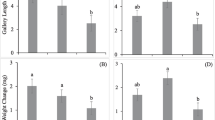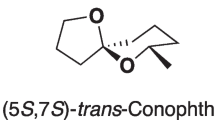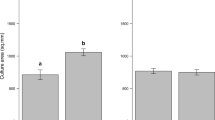Abstract
Plant secondary chemistry mediates the ability of herbivores to locate, accept and survive on potential host plants. We examined the relationship between attack by the cerambycid beetle Phoracantha solida and the chemistry of the secondary phloem (inner bark) of two differentially attacked plantation forestry taxa, Corymbia variegata and its hybrid with C. torelliana. We hypothesised that this differential rate of attack may have to do with differences in secondary chemistry between the taxa. We found differences in the bark chemistry of the taxa, both with respect to phenolic compounds and terpenoids. We could detect no difference between bored and non-bored C. variegata trees (the less preferred, but co-evolved host). Hybrid trees were not different in levels of total polyphenols, flavanols or terpenes according to attack status, but acetone extracts were significantly different between bored and non-bored trees. We propose that variations in the bark chemistry explain the differential attack rate between C. variegata and the hybrid hosts.


Similar content being viewed by others
References
Allison JD, Borden JH, Seybold SJ (2004) A review of the chemical ecology of the Cerambycidae (Coleoptera). Chemoecol 14:123–150
Barata EN, Araújo J (2001) Olfactory orientation responses of the eucalyptus woodborer, Phoracantha semipunctata, to host plant in a wind tunnel. Physiol Entomol 26:26–37
Barata EN, Fonseca PJ, Mateus E, Araujo J (1992) Host-finding by Phoracantha semipunctata: host volatiles, electroantennogram recordings and baited field traps. In: Menken SBJ, Visser JH, Harrewijn P (eds) Proceedings of the 8th International Symposium on Insect-Plant Relationships. Springer, Netherlands, pp 133–135
Barata EN, Pickett JA, Wadhams LJ, Woodcock CM, Mustaparta H (2000) Identification of host and nonhost semiochemicals of eucalyptus woodborer Phoracantha semipunctata by gas chromatography–electroantennography. J Chem Ecol 26:1877–1895
Barata E, Mustaparta H, Pickett J, Wadhams L, Araujo J (2002) Encoding of host and non-host plant odours by receptor neurones in the eucalyptus woodborer, Phoracantha semipunctata (Coleoptera: Cerambycidae). J Comp Physiol A 188:121–133
Bernays EA (1981) Plant tannins and insect herbivores: an appraisal. Ecol Entomol 6:353–360
Boland DJ, Brooker MH, Chippendale GM, Hall N, Hyland BPM, Johnston RD, Kleinig DA, Turner JD (2006) Forest trees of Australia. CSIRO Publishing, Melbourne
Cadahia E, Conde F, Fernandez de Simon B, Garcia-Vallejo MC (1997) Tannin composition of Eucalyptus camaldulensis, E. globulus and E. rudis. Part II Bark Holzforsch 51:125–129
Carnegie AJ, Lawson SA, Smith TE, Pegg GS, Stone C, McDonald JM (2008) Healthy hardwoods: a field guide to pests, diseases and nutritional disorders in subtropical hardwoods. Forest and Wood Products Australia, Melbourne
Carr SGM, Carr DJ (1969) Oil glands and ducts in Eucalyptus L’Hérit. I the phloem and the pith. Aust J Bot 17:471–513
Clarke KR (1993) Non-parametric multivariate analysis of changes in community structure. Aust J Ecol 18:117–143
Clarke KR, Gorley RN (2001) PRIMER v5: User Manual/Tutorial. PRIMER-E, Plymouth
Copolovici L, Niinemets U (2010) Flooding induced emissions of volatile signalling compounds in three tree species with differing waterlogging tolerance. Plant Cell Environ 33:1582–1594
Duffy EAJ (1963) A monograph of the immature stages of Australasian timber beetles (Cerambycidae). British Museum (Natural History), London
Elliott HJ, Ohmart CP, Wylie FR (1998) Insect pests of Australian forests. Inkata Press, Melbourne
Eyles A, Davies NW, Yuan ZQ, Mohammed C (2003) Host responses to natural infection by Cytonaema sp. in the aerial bark of Eucalyptus globulus. For Path 33:317–331
Eyles A, Bonello P, Ganley R, Mohammed C (2010) Induced resistance to pests and pathogens in trees. New Phytol 185:893–908
Farr JD, Dick SG, Williams MR, Wheeler IB (2000) Incidence of the bullseye borer (Phoracantha acanthocera (Macleay), Cerambycidae) in 20–35 year old regrowth karri in the south west of Western Australia. Aust For 63:107–123
Faucheux MJ (2012) Ovipositor sensilla of the yellow longicorn beetle Phoracantha recurva Newman, 1840 (Coleoptera: Cerambycidae). Bull Inst Sci Rabat 34:11–18
Franceschi VR, Krokene P, Christiansen E, Krekling T (2005) Anatomical and chemical defenses of conifer bark against bark beetles and other pests. New Phytol 167:353–375
Griffiths M, Wylie R, Lawson S, Pegg G, McDonald J (2004) Known or potential threats from pests and diseases to prospective tree species for high value timber plantings in northern Australia. In: Bevege DI, Bristow M, Nikles DG, Skelton DJ (eds) Prospects for high-value hardwood timber plantations in the ‘dry’ tropics of northern Australia Proceedings of a Workshop held 19–21 October, 2004. Private Forestry North Queensland Association Inc, Mareeba
Haddan M, Sauvard D, Lieutier F (2010) Tree factors in relation to success of artifical introductions of Phoracantha recurva larvae in various Eucalyptus species in Morocco. Redia 93:19–30
Hallgren P, Ikonen A, Hjältén J, Roininen H (2003) Inheritance patterns of phenolics in F1, F2, and back-cross hybrids of willows: implications for herbivore responses to hybrid plants. J Chem Ecol 29:1143–1158
Hanks LM, Paine TD, Millar JG (1991) Mechanisms of resistance in Eucalyptus against larvae of the eucalyptus longhorned borer (Coleoptera: Cerambycidae). Environ Entomol 20:1583–1588
Hayes RA, Morelli TL, Wright PC (2006) Volatile components of lemur scent secretions vary throughout the year. Am J Primatol 68:1202–1207
Hayes RA, Nahrung HF, Lee DJ (2013) Consequences of Corymbia (Myrtaceae) hybridisation on leaf-oil profiles. Aust J Bot 61:52–59
Henery ML, Henson M, Wallis IR, Stone C, Foley WJ (2008) Predicting crown damage to Eucalyptus grandis by Paropsis atomaria with direct and indirect measures of leaf composition. For Ecol Manage 255:3642–3651
Iglesias-Trabado G, Wilstermann D (2008) Eucalyptus universalis. Global cultivated eucalypt forests map 2008. Version 1.0.1.: GIT Forestry Consulting’s EUCALYPTOLOGICS
Lee DJ (2007) Achievements in forest tree genetic improvement in Australia and New Zealand 2: development of Corymbia species and hybrids for plantations in eastern Australia. Aust For 70:11–16
Lee DJ, Huth JR, Brawner JT, Dickinson GR (2009) Comparative performance of Corymbia hybrids and parental species in subtropical Queensland and implications for breeding and deployment. Silv Genet 58:205–212
Lee DJ, Huth JR, Osborne DO, Hogg BW (2010) Selecting hardwood varieties for fibre production in Queensland’s subtropics. Aust For 73:106
Nahrung HF, Waugh R, Hayes RA (2009) Corymbia species and hybrids: chemical and physical foliar attributes and implications for herbivory. J Chem Ecol 35:1043–1053
Nahrung HF, Smith TE, Wiegand AN, Lawson SA, Debuse VJ (2014) Host tree influences on longicorn beetle (Coleoptera: Cerambycidae) attack in subtropical Corymbia (Myrtales: Myrtaceae). Environ Entomol 43:37–46. doi:10.1603/EN13133
Niinemets U (2010) Responses of forest trees to single and multiple environmental stresses from seedlings to mature plants: past stress history, stress interactions, tolerance and acclimation. For Ecol Manage 260:1623–1639
Oliver JE, Crystal MM (1972) Chemosterilants against screwworm flies. J Econ Entomol 65:303–306
Paine TD, Stephen FM, Cates RG (1988) Phenology of an induced response in loblolly pine following inoculation of fungi associated with the southern pine beetle. Can J For Res 18:1556–1562
Paine TD, Steinbauer MJ, Lawson SA (2011) Native and exotic pests of Eucalyptus: a worldwide perspective. Ann Rev Entomol 56:181–201
Parra-O C, Bayly MJ, Drinnan A, Udovicic F, Ladiges PY (2009) Phylogeny, major clades and infrageneric classification of Corymbia (Myrtaceae), based on nuclear ribisomal DNA and morphology. Aust Syst Bot 22:384–399
Pizzo B, Pometti C, Charpentier J-P, Boizot N, Saidman B (2011) Relationships involving several types of extractives of five native Argentine wood species of genera Prosopis and Acacia. Ind Crops Prod 34:851–859
Singleton V, Rossi JJ (1965) Colorimetry of total phenolics with phosphomolybdic-phosphotungstic acid reagents. Am J Enol Vitic 16:144–158
Steindel F, Beauchamp J, Hansel A, Kesselmeier J, Kleist E, Kuhn U, Wisthaler A, Wildt J (2005) Stress induced VOC emissions from mildew infested oak. Geophys Res Abs 7: EGU05-A-03010
Treutter D (1989) Chemical reaction detection of catechins and proanthocyanidins with 4-dimethylaminocinnamaldehyde. J Chromatog A 467:185–193
Turnball JW (2000) Economic and social importance of eucalypts. In: Keane PJ, Kile GA, Podger FD, Brown BN (eds) Diseases and pathogens of eucalypts. CSIRO Publishing, Melbourne, pp 1–9
Wang Q (1995) A taxonomic revision of the Australian genus Phoracantha Newman (Coleotpera: Chrysomelidae). Invert Taxon 9:865–958
Zangerl AR, Berenbaum MR (1993) Plant chemistry, insect adaptations to plant chemistry, and host plant utilization patterns. Ecol 74:47–54
Acknowledgments
We sincerely thank Michael O’Loughlin, Fred Oudyn (DSITIA) and Lesley Francis (DAFF) for access to equipment and advice and assistance with spectrophotometric analyses and to A/Prof David Lee (USC/DAFF) for tree germplasm. Thanks to Forest Plantations Qld for establishment and access to the field site. This work was partially funded by Plantation Hardwoods Research and Development Fund, Elders Forestry and HQPlantations (formerly FPQ).
Author information
Authors and Affiliations
Corresponding author
Additional information
Handling Editor: Kerstin Reifenrath.
Rights and permissions
About this article
Cite this article
Hayes, R.A., Piggott, A.M., Smith, T.E. et al. Corymbia phloem phenolics, tannins and terpenoids: interactions with a cerambycid borer. Chemoecology 24, 95–103 (2014). https://doi.org/10.1007/s00049-014-0153-6
Received:
Accepted:
Published:
Issue Date:
DOI: https://doi.org/10.1007/s00049-014-0153-6




